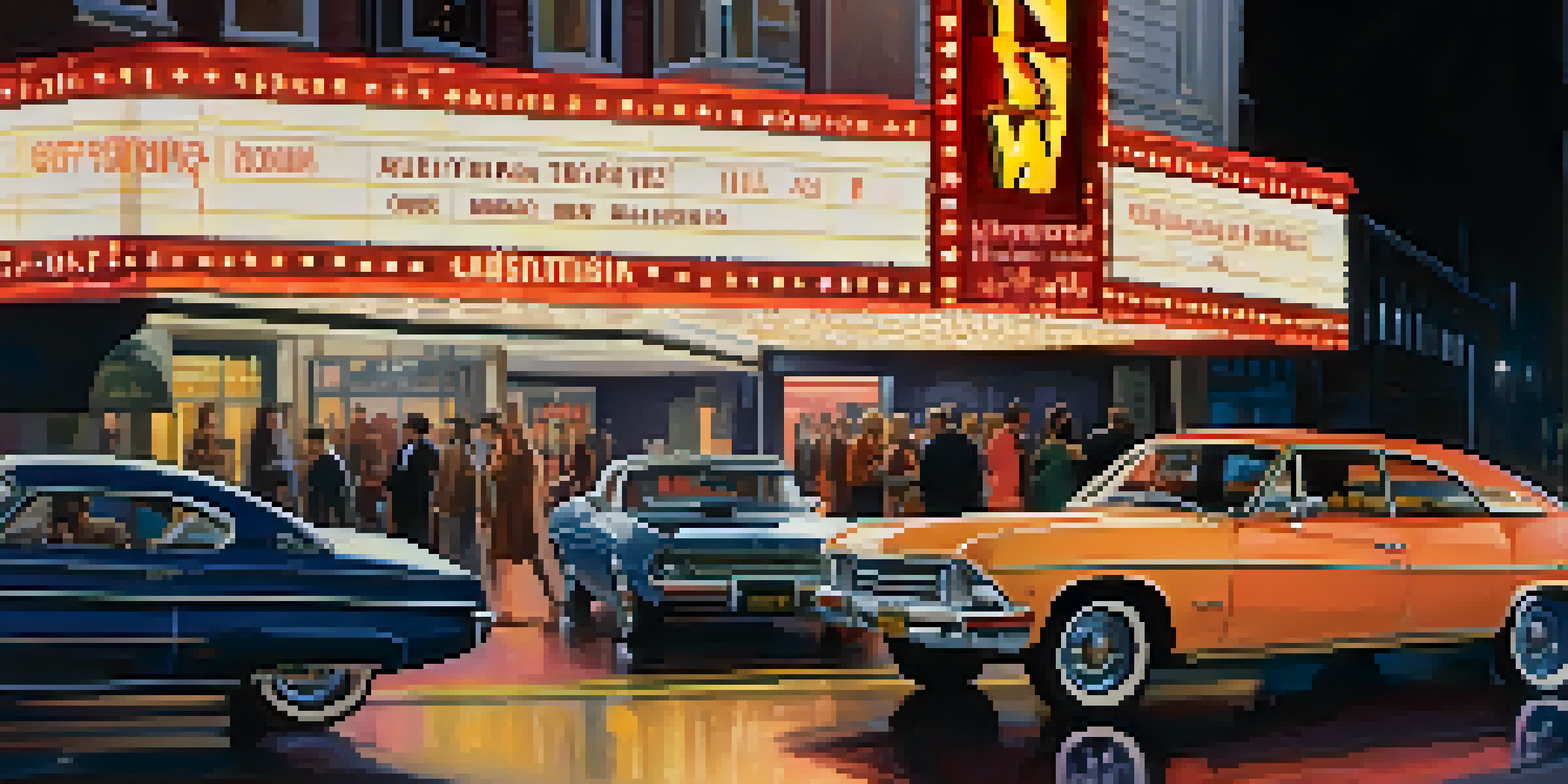The X Rating: Impact on Artistic Expression in the 1970s

Introduction to the X Rating and Its Origins
The X rating emerged in the late 1960s as a designation for films featuring adult content. Unlike the later NC-17 rating, X did not have a strict definition but was broadly understood to signify explicit material. This rating became a cultural touchstone, shaping how audiences perceived mature themes in cinema during the 1970s.
Cinema is a matter of what's in the frame and what's out.
As filmmakers began to explore previously taboo subjects, the X rating provided a certain level of freedom from censorship. Directors and writers felt emboldened to tackle complex issues such as sexuality, violence, and social injustice. This era saw a significant shift in the types of stories being told, reflecting a more open and experimental approach to filmmaking.
However, the X rating also carried a stigma, often leading to limited distribution and marketing challenges. Many theaters were hesitant to screen X-rated films, which pushed filmmakers to find creative ways to reach audiences. This tension between artistic expression and commercial viability defined much of the cinematic landscape in the 1970s.
Cinematic Innovations Driven by the X Rating
With the X rating granting filmmakers more creative freedom, the 1970s became a golden age for innovative storytelling. Directors like Martin Scorsese and Francis Ford Coppola pushed boundaries, incorporating raw and unfiltered narratives. Films such as 'Taxi Driver' and 'The Godfather' not only showcased intense themes but also introduced groundbreaking cinematic techniques that influenced generations.

The X rating encouraged filmmakers to experiment with visual and narrative styles, leading to a richer cinematic language. For instance, the use of non-linear storytelling and unpredictable character arcs became more common as creators sought to convey complex emotional truths. This experimentation paved the way for future avant-garde cinema, enhancing the artistic landscape.
X Rating's Cultural Impact
The X rating allowed filmmakers in the 1970s to explore mature themes, transforming cinema into a platform for bold artistic expression.
Moreover, as films began to reflect real societal issues, the audience's expectations evolved. Viewers sought authentic representations of life, which meant that directors were compelled to delve deeper into human experiences. The X rating became a symbol of this quest for authenticity, marking a departure from the idealized portrayals of the past.
Controversial Themes in X-Rated Films
The 1970s saw an influx of films that tackled controversial themes, often under the X rating banner. Movies like 'Last Tango in Paris' and 'Deep Throat' sparked significant public discourse about sexuality and morality. These films not only challenged societal norms but also ignited debates about censorship and the role of cinema in exploring adult themes.
Film is a powerful medium for social change, but it must also be entertaining.
While some celebrated these films for their boldness, others criticized them for perceived exploitation. This dichotomy highlighted the ongoing struggle between artistic expression and moral boundaries. As a result, filmmakers often found themselves navigating a precarious tightrope, balancing their creative visions with audience sensitivities.
Despite the controversies, these films played a crucial role in expanding the definition of cinema. They opened doors for discussions about sex, power, and personal identity, making way for future filmmakers to explore similar themes without the same level of stigma. The X rating thus became a catalyst for change in how stories were told and received.
The Role of the X Rating in Independent Cinema
The X rating also significantly impacted independent filmmakers during the 1970s. Unlike Hollywood studios, independents were often more willing to embrace the rating as a badge of honor rather than a deterrent. This acceptance allowed them to create bold, unconventional films that resonated with niche audiences.
Independent films like 'Pink Flamingos' and 'The Bitter Tears of Petra von Kant' utilized the X rating to challenge societal norms and expectations. They explored themes of sexuality, identity, and rebellion, often pushing the envelope further than mainstream cinema would allow. This creative freedom fostered a vibrant indie film culture that celebrated diversity and alternative narratives.
Innovations in Storytelling
Filmmakers utilized the X rating to push narrative boundaries, leading to groundbreaking techniques that influenced future cinema.
Moreover, the success of X-rated independent films demonstrated that there was a significant audience for explicit content. This realization encouraged more filmmakers to take risks, leading to a flourishing of creative expression. The X rating thus became synonymous with innovation and artistic courage in independent cinema.
The X Rating's Impact on Audience Reception
The introduction of the X rating altered how audiences engaged with films. Many viewers began seeking out X-rated films, intrigued by their reputation for being provocative and daring. This shift in audience behavior created a demand for movies that challenged conventional narratives and explored complex themes.
As a result, X-rated films often fostered a sense of community among viewers, who gathered to discuss and analyze the content. This camaraderie was particularly evident in urban centers, where midnight screenings became popular. These events transformed the viewing experience into a shared cultural phenomenon, encouraging open conversations about topics that were once considered taboo.
However, the X rating also led to polarization among audiences. While some embraced the frankness of X-rated films, others were put off by their explicit nature. This division prompted filmmakers to consider their target demographics more carefully, shaping future projects and marketing strategies.
The Decline of the X Rating and Its Legacy
By the late 1970s, the X rating began to lose its cultural cachet, primarily due to its association with adult films. The rise of the NC-17 rating in the late '80s attempted to reclaim some of the artistic integrity that the X rating once held. However, the damage was done, and mainstream acceptance of explicit content had shifted significantly.
This decline marked the end of an era for many filmmakers who had relied on the X rating to push boundaries. Yet, the legacy of this rating continues to influence contemporary cinema, reminding us of the power of artistic expression. Today's filmmakers still draw inspiration from the bold narratives and innovative storytelling techniques that emerged during the 1970s.
Legacy of the X Rating
Despite its decline, the X rating's legacy continues to inspire contemporary filmmakers to challenge societal norms and pursue authentic storytelling.
Moreover, the conversations sparked by X-rated films laid the groundwork for current discussions about representation and censorship in cinema. The fight for creative freedom continues, echoing the struggles faced by artists in the past. Ultimately, the X rating stands as a testament to the transformative power of art and the ongoing quest for authenticity in storytelling.
Conclusion: The X Rating's Enduring Influence on Art
The X rating undoubtedly shaped the landscape of artistic expression in the 1970s, allowing filmmakers to explore uncharted territories. Its legacy lives on, reminding us of the importance of pushing boundaries and challenging societal norms. As we reflect on this era, we can appreciate how the X rating facilitated a dialogue about art, morality, and the human experience.
While the rating itself may have evolved, the spirit of artistic freedom it represented continues to inspire creators today. Filmmakers from all genres are encouraged to express their visions authentically, regardless of the subject matter. This ongoing pursuit of truth in storytelling is a direct reflection of the changes initiated during the 1970s.

Ultimately, the X rating serves as a reminder of the power of cinema to provoke thought, evoke emotion, and inspire change. It paved the way for a more inclusive and diverse range of narratives, inviting future generations of filmmakers to continue exploring the complexities of the human condition.